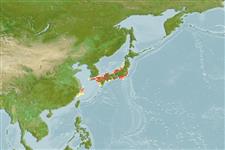Common names from other countries
Classification / Names
आम नाम | उपशब्द | Catalog of Fishes(वर्ग, प्रजाति) | ITIS | CoL | WoRMS | Cloffa
>
Gobiiformes (Gobies) >
Gobiidae (Gobies) > Gobiinae
Etymology: Platygobiopsis: Greek, platys = flat + Latin, gobius = gudgeon + Greek, opsis = appearance (Ref. 45335); tansei: Named 'Tansei' for the research vessel Tanseimaru of the Ocean Research Institute, University of Tokyo (or Japan Marine Science and Technology Center) for collecting many Suruga Bay specimens including the holotype; noun in apposition..
Environment: milieu / climate zone / depth range / distribution range
पारिस्थितिकी
समुद्री ड़िमरसल; गहराई सीमा 60 - 136 m (Ref. 75206). Temperate
Northwest Pacific: Japan.
आकार / वज़न / Age
Maturity: Lm ? range ? - ? cm
Max length : 4.7 cm SL पुल्लिंग / अलिंग; (Ref. 75206)
Short description
पहचान कुंजी | आकृति विज्ञान | मौरफोमैटरिक्स
पृष्ठीय रीढ़ (सम्पूर्ण) : 7; पृष्ठीय सौफट रेज़ (सम्पूर्ण) : 13 - 14; गुदा कांटा: 1; ऐनल सौफट रेज़: 12 - 14; जानवरों की रीड़ का जोड़: 26. This species is distinguished by the following characters: D VI, I, 13-14; outer gill rakers on first gill arch 0+9-10; no chin barbel; predorsal scales reaching anteriorly to transverse line through middle of operculum; no scales from pectoral-fin base; cephalic sensory-canal pores absent; pelvic-fin frenum absent (Ref. 75206).
A true benthic species in the sloping sandy mud bottoms, often residing in the bottom sediment itself. In Suruga Bay, P. tansei was often found in beam trawl collections containing a lot of sandy mud sediments, probably due to the less than flat bottom configuration of the habitat (Ref. 75206).
Life cycle and mating behavior
Maturities | पुनरुत्पत्ति | Spawnings | Egg(s) | Fecundities | लार्वा
Okiyama, M., 2008. Platygobiopsis tansei, a new species of dorso-ventrally flattened gobiid fish from Southern Japan. Bull. Natl. Mus. Nat. Sci. Ser. A. Suppl. 2:85-96. (Ref. 75206)
IUCN Red List Status (Ref. 130435)
CITES (Ref. 128078)
Not Evaluated
Threat to humans
Harmless
Human uses
साधन
Special reports
Download XML
इंटरनेट स्रोत
Estimates based on models
Phylogenetic diversity index (Ref.
82804): PD
50 = 0.6250 [Uniqueness, from 0.5 = low to 2.0 = high].
Bayesian length-weight: a=0.01023 (0.00477 - 0.02194), b=3.02 (2.84 - 3.20), in cm Total Length, based on LWR estimates for this (Sub)family-body shape (Ref.
93245).
Trophic level (Ref.
69278): 3.2 ±0.3 se; based on size and trophs of closest relatives
लौटाव (Ref.
120179): ऊंचा, न्यूनतम जनसंख्या दुगनी समय अवलागत 15 महीने। (Preliminary K or Fecundity.).
Fishing Vulnerability (Ref.
59153): Low vulnerability (10 of 100).
